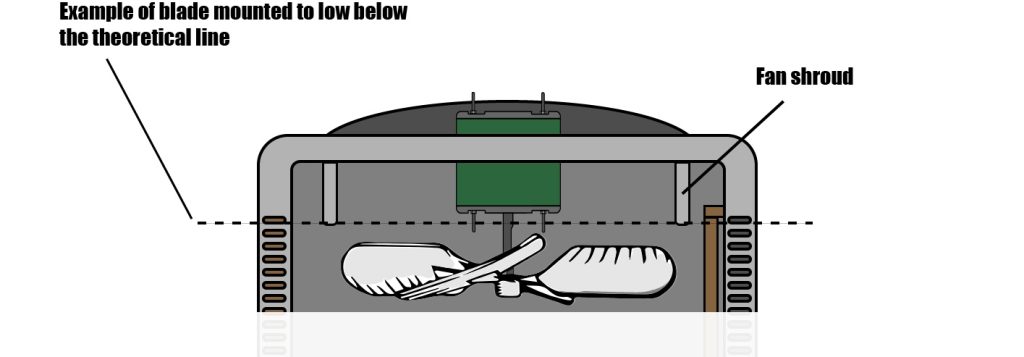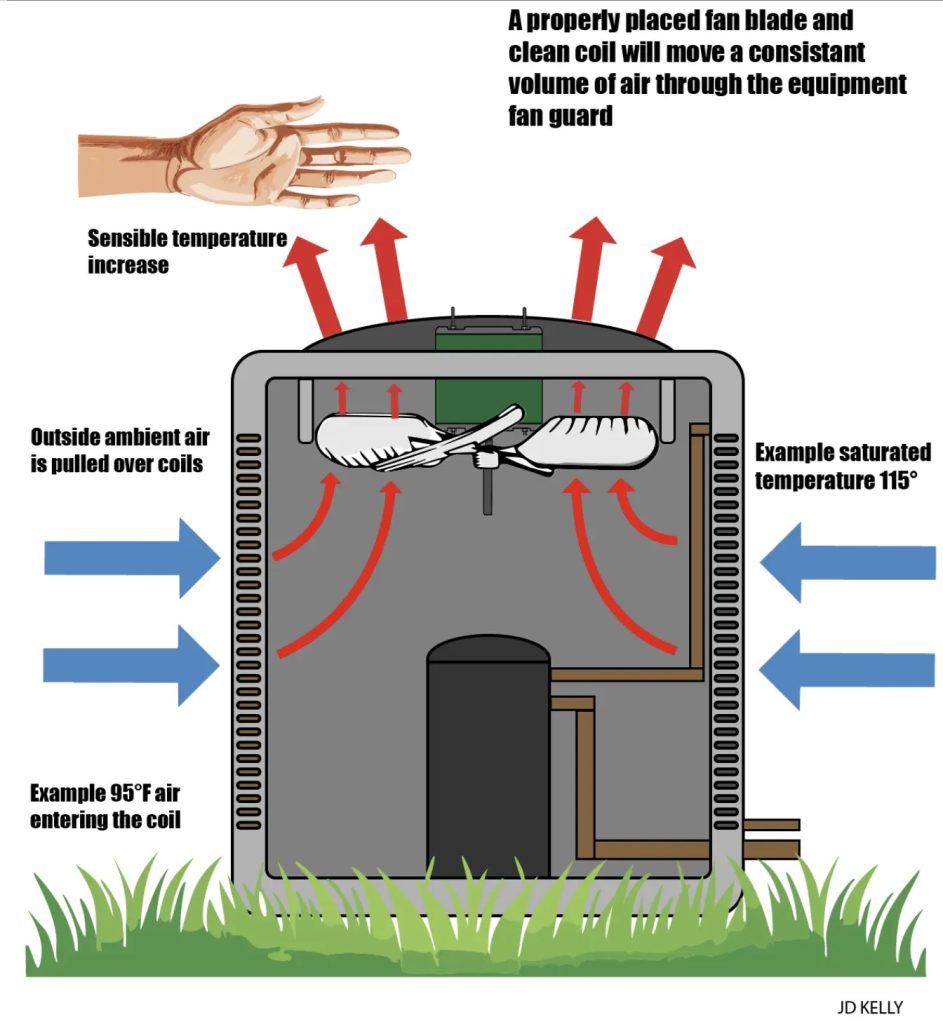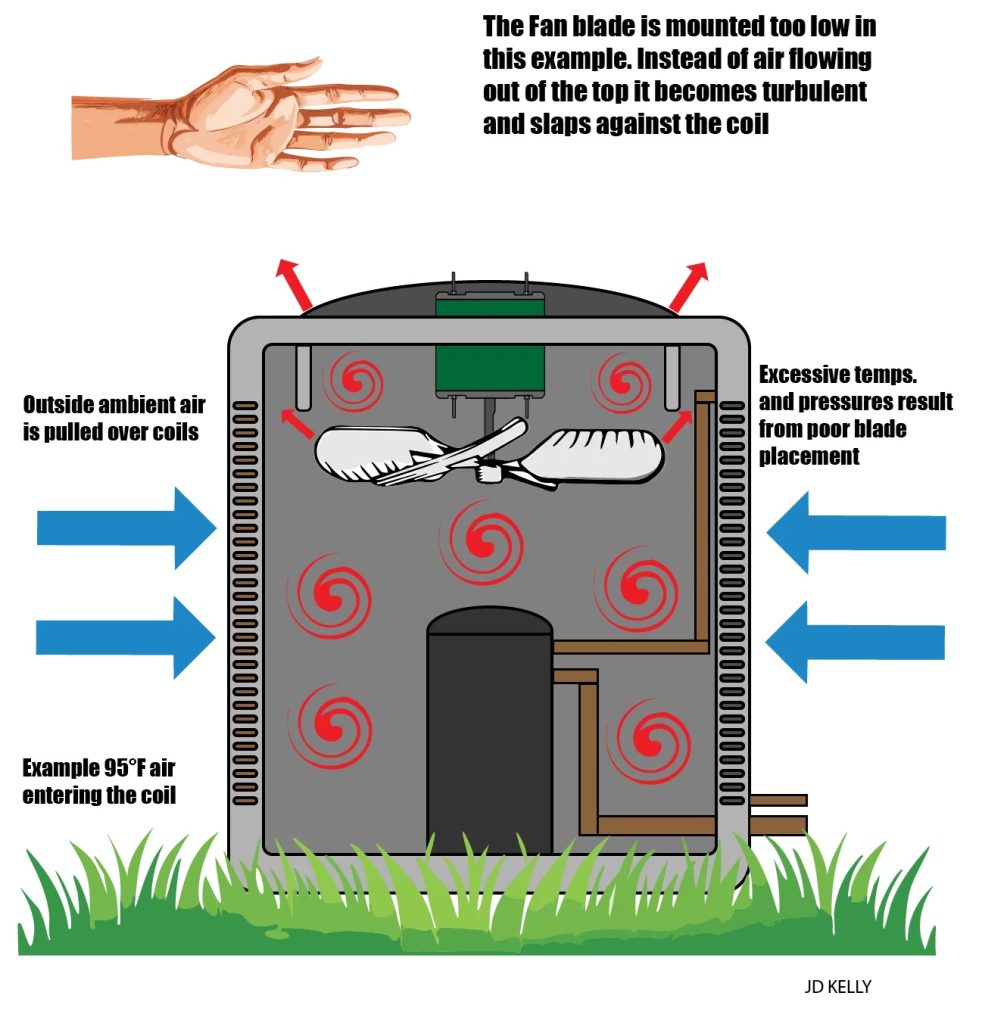Get Tech Tips
Subscribe to free tech tips.
Condenser Fan Blade Placement
In a previous article, I talked about wiring permanent split capacitor (PSC) condenser fan motors. While researching the topic, I realized that there isn’t as much information available on condenser motors as there is on their counterpart—the indoor blower motor. I had never really given it much thought, as I assumed that the condenser motor was just a simple plug-and-play replacement part that didn’t require any special considerations; it’s not like we need to select condensing fan motors to overcome static pressure in ductwork or hit CFM targets.
Regardless, outdoor fan motors are responsible for the lion's share of the system’s work. Blower motors pull air over the coil, which enables the evaporator to absorb heat. Rejecting that heat is of equal importance to the refrigeration cycle, so why do we place so little emphasis on outdoor fan motors?
The condenser fan motor is responsible for turning the fan blade that draws air over the outdoor coil, and heat is transferred and rejected to the outside air as it passes through the condenser coil. That’s all pretty straightforward, but there are some performance considerations that we’d be wise to keep in mind. For instance, head pressure can be affected by blade placement on the motor shaft. Blade depth will also have a major impact on the system’s ability to reject heat.
In this article, we are going to take a look at fan blade placement and shed some light on this often-overlooked component of the air conditioning system.
What a Condenser Motor Is and What it Does
Quite simply, a condenser motor is found in the condensing unit and is responsible for turning the fan blade that draws air through the condensing coil. This air, referred to as outside ambient air, collects heat from the coils as it passes through the condenser channels or fins. The air is then expelled out of the top of the unit, and if functioning correctly, it should be sensibly higher in temperature than the entering ambient air. This part of the refrigeration cycle is critical, as all the heat that has been absorbed from the inside air is released outside as the refrigerant condenses back into its liquid state.
There is so much more technical info about the refrigeration cycle that can be found on the HVAC School website, but I want to zero in on the condenser fan blade—specifically its placement.
Blade Placement
Blade placement has to do with the depth or position along the motor shaft in relation to the fan shroud. Most condenser cabinets manufactured by reputable companies have a very specifically engineered fan shroud that, in conjunction with a properly mounted fan blade, allows for maximum efficiency and air movement.
A properly mounted fan blade should be mounted as the manufacturer suggests, which usually means ⅓ of the fan blade will be above the fan shroud with ⅔ being below. This placement allows the fan blade to scoop the air and expel the massive quantity of air required for the refrigeration cycle to work.

A blade hanging too low can cause the air to be turbulent, resulting in poor throw out of the condenser cabinet. This can result in poor heat transfer, causing the condenser coil to heat up, which drives head pressures to high levels and can result in a number of unintended problems with the unit.

Determining Proper Blade Placement
The easy answer to determining blade depth would be to check manufacturers' literature. But let’s be honest: the information is just not available in more instances than not.
There are a few approaches to this. The first is to measure the distance between the existing fan blade collar and the condensing unit fan guard. Note that I mentioned measuring to the fan guard and not to the fan motor casing. The reason for this is that you are more than likely replacing this motor with a universal motor. The universal motor will likely have dimensions that are different from those of the OEM.

This method is contingent on the idea that the condenser fan blade being measured is in its designed position, to begin with. It’s possible that someone may have previously changed the fan depth during prior service calls, and it’s not impossible to think that the unit may have come from the manufacturer improperly placed—it’s unlikely but not impossible.
A good visual inspection and the use of logical reasoning will get you within reason. Then, there are some follow-up observations that will help you dial it in. My favorite tool to use in this case is the old hand-ometer.
The Hand-o-meter
On a functioning condenser, you should be able to throw the old hand-o-meter into the air stream and make some preliminary diagnostics just by feeling the air:
- The first thing you should pick up on is the flow of air. Is it steady and consistent with units known to be in good working order?
- Is the air being blown out of the fan guard at an upward angle—as opposed to being thrown diagonally from the outer perimeter of the fan guard opening?
- Does the air feel choppy or irregular?
- Can you detect a gain of sensible heat compared to the ambient air around the unit?

It just takes a little time and experience with units you know to be in good working order. You will develop a sense of how hard the air should typically blow and in what direction. Most importantly, you will be able to detect extreme temperature inconsistencies. Don’t get me wrong, you probably won’t ever be dialing in charge from hand temperature readings, but you should be able to tell that the air is either way too hot or has no sensible difference from the ambient air.
One thing that I have found to be easily perceptible by hand is the direction of the air blowing out of the fan guard. In the image below, you can see that the fan blade is mounted too low on the shaft, causing the air to be turbulent and inconsistent. I have noticed a good indicator is that the air is thrown from the fan guard diagonally from the perimeter and feels weak.

You might also be able to observe the sensible temperature differences between the ambient air entering the coil and exiting via the fan. Eventually, you’ll be able to recognize that something is off when you come across units that have been running for a while, yet you feel no temperature increase. From a good visual inspection, you can deduce that the condenser fan blade is mounted correctly, but there is no perceivable heat increase. This is a sign of issues unrelated to the fan, and you can find tons of information on compressors and the refrigeration cycle on the HVAC School website. However, it is important to develop the “Spidey Sense,” as Bryan Orr would put it, to detect these temperature inconsistencies as part of your initial contact with the equipment.

Conclusion
I think that, in general, proper condenser fan blade placement often goes overlooked—most likely because it isn’t one of those topics that people are passionate about. Another factor, if I’m perfectly honest, is that there is not a really good way to test things like CFM from the condensing unit. On the inside portion of the system, we can deploy probes to check static pressure and all sorts of other cool technology-driven tools and devices, but when it comes to condenser airflow, we are limited and usually end up making the “that’s probably good enough” statement after we throw our hand over the unit because we don’t have much choice.
To sum it up, condenser airflow is incredibly important, and though it might seem like a little thing, it’s a good idea to practice placing your hand in the airflow of every condenser you come across. You will start to develop a pretty reliable sense of what should and shouldn’t be when it comes to airflow and sensible temperature.












Comments
Good tips, JD! Thank you.
Good tips, JD! Thank you.
https://bestcanada-casinos.com/
https://bestcanada-casinos.com/
We buy ALL equipment and much more with pickup продать спб. Buying on a map of Saint Petersburg.
We buy ALL equipment and much more with pickup продать спб. Buying on a map of Saint Petersburg.
https://t.me/online_1_win/12350
https://t.me/online_1_win/12350
Appreciate the feedback!
Appreciate the feedback!
To leave a comment, you need to log in.
Log In